How to Build an AI App: Comprehensive Guide for 2026
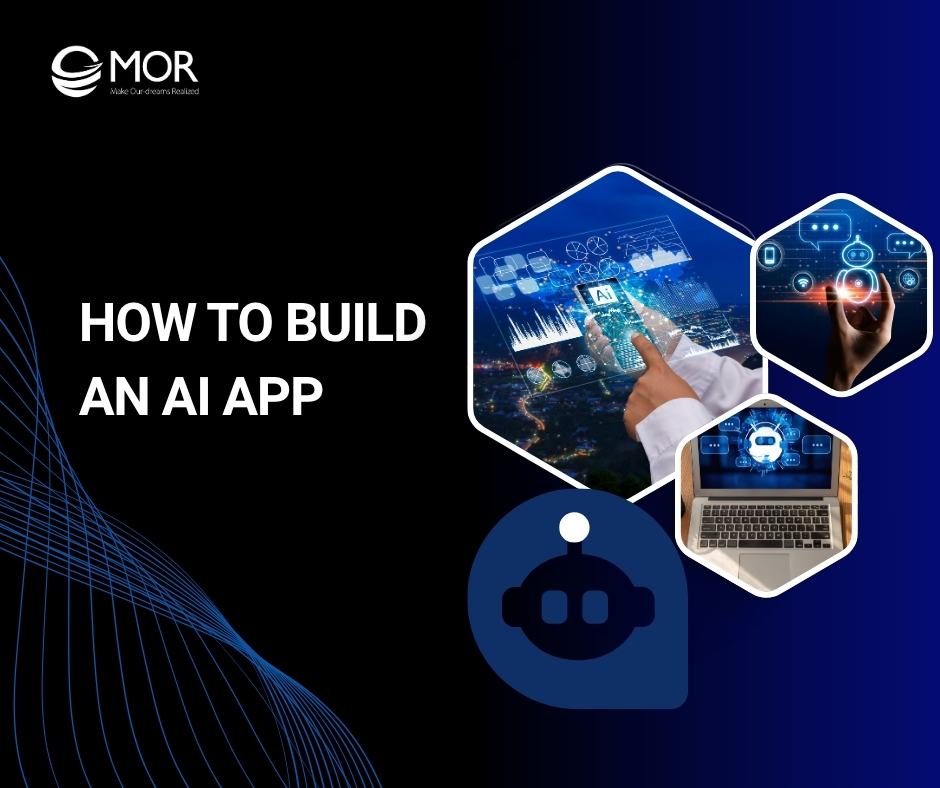
Building intelligent apps is no longer limited to big tech companies. Knowing how to build an AI app can help businesses automate tasks, improve decision-making, and deliver smarter user experiences. This MOR Software’s guide will walk you through every step, from planning and training models to launching a successful AI-powered product that meets real market needs.
What Is An AI App?
An AI app is a software program designed to perform tasks that normally need human thinking, such as recognizing patterns, understanding speech, or making predictions. It relies on machine learning, natural language processing, and other smart technologies to deliver results that go beyond fixed instructions.
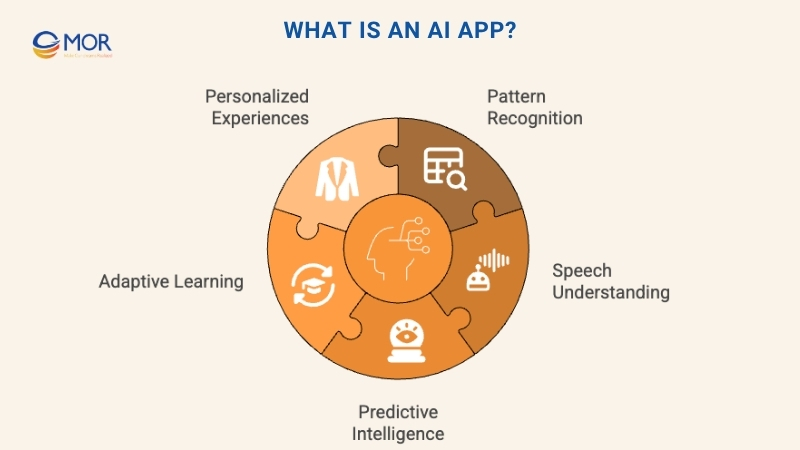
Unlike traditional apps that only follow preset rules, an AI-driven application learns and adapts as it processes more data. It studies user behavior, adjusts to feedback, and gradually becomes smarter. These learning abilities are among the key features of artificial intelligence, helping systems make better decisions and deliver more personalized experiences. In simple terms, how to build an AI app starts with creating software that can think, learn, and evolve through every user interaction.
How Is AI Used In Mobile Apps?
No matter where it operates, whether in the cloud, on the device, or through a hybrid setup, artificial intelligence is still powered by smart machine learning algorithm. These systems may be complex and costly to develop, but at their heart, they process data and deliver intelligent actions. The same logic applies to mobile platforms that use these algorithms to make everyday apps feel smarter and more responsive.
Most users don’t need to know the technical details behind deep learning or neural networks. What matters is how these systems improve user experiences and business outcomes. Companies focused on how to build an app with AI automation aim to solve real problems, not just add another layer of technology. What counts is that the app works smoothly and meets user expectations.
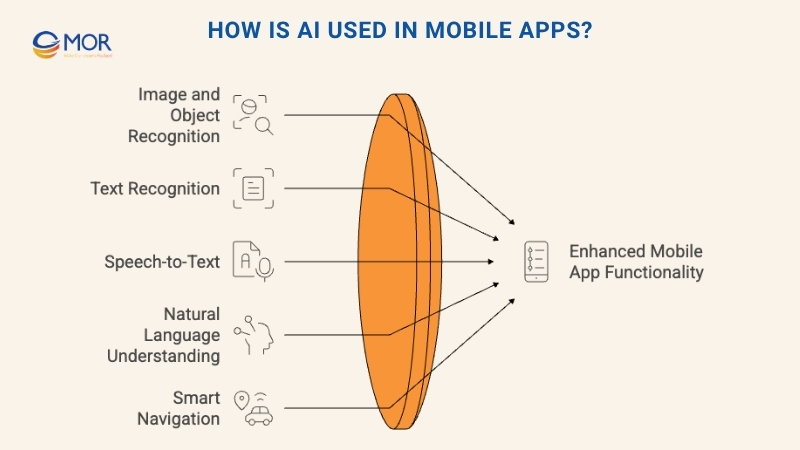
AI in mobile applications now powers tools we use daily, from virtual assistants to smart photo filters. Let’s explore how these technologies appear in some of the most popular mobile use cases today.
Image and Object Recognition
Apps like Wanna Kicks show how AI can identify and respond to visual input. The app scans the user’s feet, detects their shape, and then overlays a digital shoe model that moves in sync. This combination of computer vision and augmented reality makes the experience interactive and personal. The same technology supports healthcare systems that scan medical images or eCommerce platforms that use visual search to help users find products instantly. It’s a clear example of how AI-driven image recognition shapes the way people engage with mobile applications.
Text Recognition
Text recognition works much like object detection but focuses on written language. It allows mobile apps to scan, copy, and understand printed or handwritten text within seconds. This function helps users translate menus, extract contact details from images, or digitize documents on the go. Developers learning how to build an AI app often start with this function because it combines practicality and clear value for everyday users.
Speech-to-Text and Natural Language Understanding
Voice interaction has become a common part of mobile life. Virtual assistants such as Siri, Google Assistant, and Alexa listen, interpret, and respond through natural language processing (NLP). Beyond simple commands, this same technology enables smarter systems like a virtual nurse that detects emotions or answers health-related questions. Businesses exploring how to use AI to build an app can rely on NLP to improve customer support, automate conversations, or create interactive learning experiences.
Smart Navigation and Route Prediction
AI as a service also powers modern map and transportation apps. When users book a ride or plan a trip, the app analyzes real-time traffic, distance, and weather data to find the quickest route. It predicts arrival times with impressive accuracy and adjusts instantly when conditions change. This is another reason why how to build an app using AI has become a key focus for businesses that want to make mobile experiences more efficient and predictive.
Is It Worth Learning How To Build An AI App In 2026?
Many entrepreneurs are asking if investing in AI innovation is still worthwhile, especially when the global startup failure rate remains high. Yet, the growing demand for artificial intelligence solutions tells a different story. AI adoption continues to expand across industries, and companies exploring how to develop an AI application are seeing strong, long-term potential.
According to Statista, the generative AI market is projected to rise from 36 billion USD in 2024 to nearly 415 billion USD by 2027, reaching around 184 billion USD in 2030. These figures show just how fast intelligent technology is shaping the software market and why learning how to build an AI app has become a key skill for future-ready businesses.
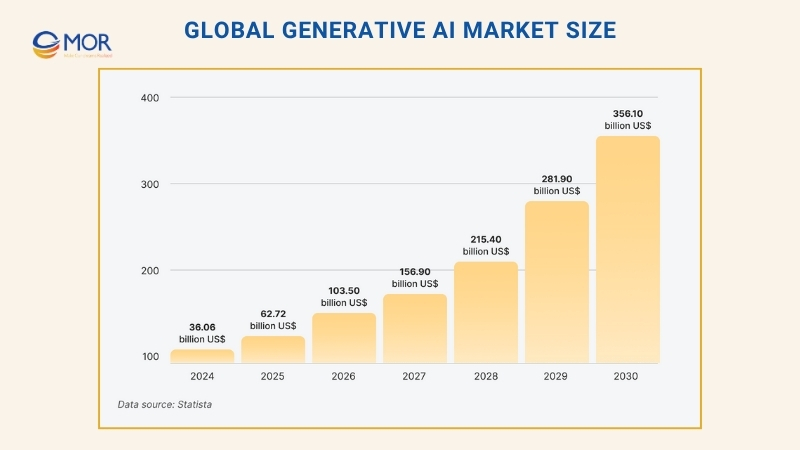
While overall startup funding has fallen by more than 60% since its 2021 peak, investor attention toward AI diversity remains strong. Reports show that venture capital continues to favor AI-driven companies, including leaders like OpenAI and xAI, which have recently secured multi-billion-dollar rounds.
For smaller startups, funding opportunities may be tighter, yet there’s still room for innovation. Entrepreneurs who focus on building practical, high-quality AI applications that solve real problems have a solid chance of success. The field remains promising for those ready to create value-driven solutions that meet genuine market needs.
Business Benefits Of AI Application Development
The value of how to build an AI app goes far beyond innovation. It delivers measurable results that directly impact business performance and customer satisfaction. Companies that focus on how to build an AI application use intelligent systems to automate operations, personalize experiences, and improve decision-making. These advancements help organizations scale faster, operate smarter, and deliver services that truly matter to users.

Automation of Repetitive Tasks
Custom AI solutions can handle daily tasks that once required manual effort. This automation saves time and reduces costs while improving accuracy. For internal teams, it means faster processes and fewer human errors. For end users, it creates smoother interactions and a more convenient experience. As automation expands, businesses can allocate their time to strategy and innovation instead of routine work.
Enhanced User Experience
Modern users expect speed, relevance, and personalization in every interaction. AI technology meets those expectations through smart recommendations, adaptive content, and predictive responses. Tools inspired by ChatGPT and other intelligent systems already use advanced models to respond to individual needs in real time. The outcome is a stronger bond between brand and customer, transforming occasional users into loyal advocates.
Data-Driven Decision Making
AI replaces guesswork with clarity. Through smart data analysis, it helps businesses uncover trends, track performance, and understand customer behavior. This insight-driven approach allows leaders to make decisions that fit real market needs instead of relying on assumptions. For those learning how to build an AI app, using data effectively can set a product apart and prevent costly missteps during development or scaling.
Predictive Analytics
Artificial intelligence also makes forecasting more accurate. With built-in predictive ml model, companies can spot market changes, detect user behavior patterns, and prepare strategies in advance. This foresight gives entrepreneurs a clear advantage, whether they’re planning new features, improving retention, or identifying growth opportunities. Predictive analytics turns raw data into early action, helping any business stay one move ahead in a fast-changing market.
Scalability
When an app attracts more users, its performance must keep up. Through smart resource management and automation, AI application development makes scaling simple and efficient. Features like automatic server load balancing and optimized search algorithms help maintain speed and reliability, even as demand increases. This ensures that the app runs smoothly without constant manual adjustments, supporting long-term growth with stability.
Stronger Security Measures
Security remains a top priority for any digital product. AI strengthens protection with advanced threat detection, real-time monitoring, and automated responses to suspicious activity. These tools help safeguard user data and keep systems resilient against attacks. For industries like finance and healthcare, where compliance and privacy are critical, this level of protection builds user confidence and reinforces brand credibility.
Top Industries Applying AI Solutions
When planning how to build AI applications, it’s important to look at industries where intelligent technology is already creating measurable results. These sectors continue to grow rapidly, offering new chances for startups and established companies alike.
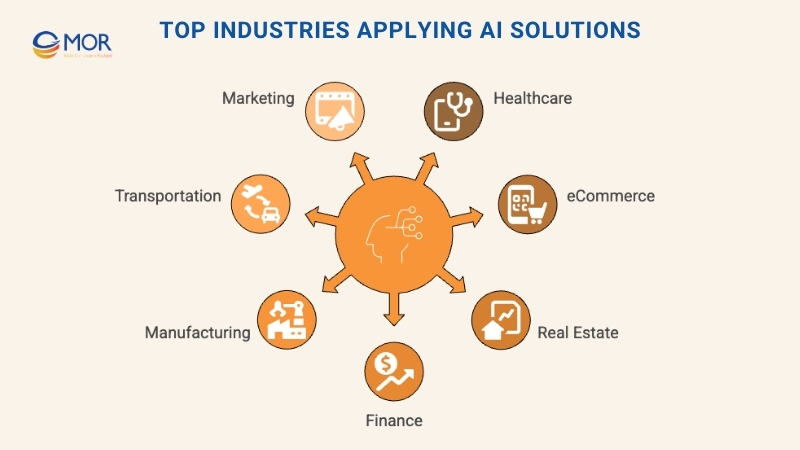
- Healthcare: Hospitals and clinics are using AI and machine learning in healthcare to improve diagnostics, personalize treatment, and predict patient outcomes. Tools powered by predictive analytics and medical imaging help doctors make faster and more accurate decisions.
- eCommerce: Online retailers depend on AI for product recommendations, pricing insights, and inventory control. Smart algorithms analyze customer data to create personalized shopping experiences that increase satisfaction and drive repeat purchases.
- Real Estate: AI supports property valuation, price forecasting, and market analysis. Intelligent chatbots handle inquiries instantly, while AI algorithms review huge datasets to reveal buyer trends and guide investment strategies.
- Finance: Banks and fintech companies rely on AI for fraud detection, risk management, and automated trading. Machine learning helps detect irregular patterns in financial data, reducing loss and improving transparency.
- Manufacturing: Factories use AI for predictive maintenance, production scheduling, and quality assurance. Those exploring how to build an AI app in this field can use smart systems to detect faults early, prevent downtime, and optimize the supply chain.
- Transportation: From logistics to self-driving vehicles, AI improves routing, reduces fuel costs, and supports real-time traffic management. Predictive systems help companies deliver goods faster and more reliably.
- Marketing: In today’s digital world, AI shapes customer engagement. It helps personalize messages, automate campaigns, and forecast behavior. Modern AI writing tools also assist in creating content that speaks directly to target audiences, improving reach and conversions.
How To Build An AI App: Key Elements And Components
Learning how to build an AI app means understanding the building blocks that bring it to life. Each component works together to form a system that can think, learn, and respond intelligently. When planned carefully, these elements create a product that is both smart and adaptable, no matter if it’s a mobile or web platform. Businesses often start with these essential parts to ensure success from the ground up.
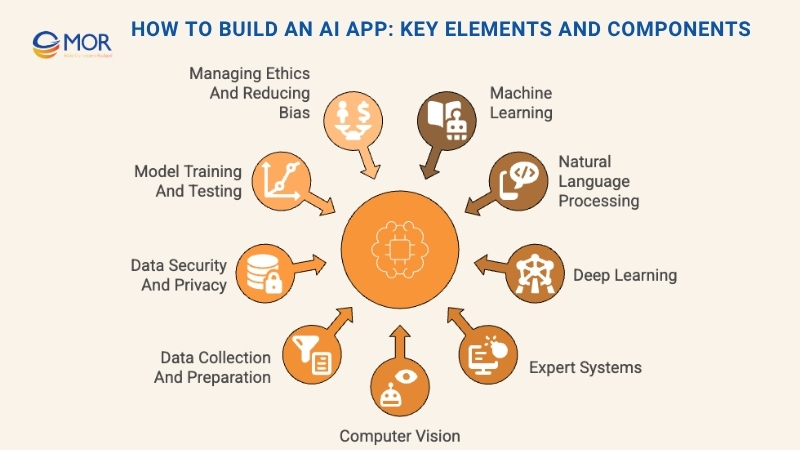
1. Machine Learning (ML)
Machine Learning acts as the core intelligence of any AI solution. It enables systems to study data, identify patterns, and improve continuously without constant programming input. Using reliable data pipelines and integration tools helps organize information for accurate model training. This structure is what turns a simple application into a system that learns and grows with every interaction, making it a key part of building AI applications that evolve over time.
2. Natural Language Processing (NLP)
NLP allows machines to understand, interpret, and respond to human language naturally. It powers chatbots that hold real conversations and translation tools that break down language barriers. When businesses plan how to create an AI app from scratch, mastering NLP becomes vital for creating intuitive communication features that feel personal and human.
3. Deep Learning
Deep Learning takes machine learning a step further. It relies on multi-layered neural networks to process large volumes of data and identify complex patterns that humans might overlook. This approach is essential for those exploring how to build an AI powered app, as it allows the system to handle advanced functions like image recognition, natural speech, and predictive modeling with greater precision.
4. Expert Systems
Expert systems act as digital specialists within your application. They use structured knowledge bases and logical rules to make decisions similar to human experts. In industries like healthcare, finance, or engineering, these systems analyze data, evaluate scenarios, and provide recommendations that support faster and more accurate results.
5. Computer Vision
Computer vision gives AI the ability to “see.” It allows machines to recognize, process, and interpret visual data such as photos, videos, or live camera input. This technology powers everything from facial recognition and quality inspection to autonomous vehicles. For developers learning how to build an app using AI, integrating computer vision can open the door to powerful visual-based experiences that feel truly intelligent.
6. Data Collection and Preparation
Every intelligent system starts with quality data. Gathering and organizing information gives your app the foundation it needs to learn effectively. Developers working on how to build an AI app focus first on collecting clean, diverse, and relevant datasets that reflect real-world conditions. This step ensures that the model understands patterns accurately and produces dependable results later.
7. Data Security and Privacy
Trust begins with protection. In AI development services, keeping user data safe is a top priority. Strong encryption, access control, and software composition analysis help identify weak points and reduce risks. When handled responsibly, data security not only meets industry regulations but also builds long-term confidence among users and stakeholders.
8. Model Training and Testing
Once the data is ready, the model needs to learn. This process involves training algorithms to recognize trends, predict outcomes, or make choices. Using data labeling tools can make this stage faster and more accurate. For anyone studying how to build an AI app, mastering model training is what turns static data into smart, decision-making technology.
9. Managing Ethics and Reducing Bias
Responsible AI means fairness and transparency. Every team creating an intelligent product must look for bias in its datasets and decision models. Recognizing and correcting these patterns ensures balanced outcomes and trustworthy performance. Ethical awareness is not just a guideline, it’s an ongoing commitment to developing technology that benefits everyone.
Step-by-Step Process On How To Build An AI App
So, what exactly goes into creating an intelligent application? The process of how to build an AI app has many similarities with standard software development, but it also includes a few special stages that focus on model design and training. Unlike traditional apps, AI-driven solutions depend on data learning and continuous improvement, not just static programming.
Most modern AI mobile products work as standard front ends connected to a cloud-based AI engine. That means the development path blends classic mobile practices with specialized AI integration. Businesses learning how to build an app using AI should view this as a natural extension of existing workflows rather than a complete reinvention.
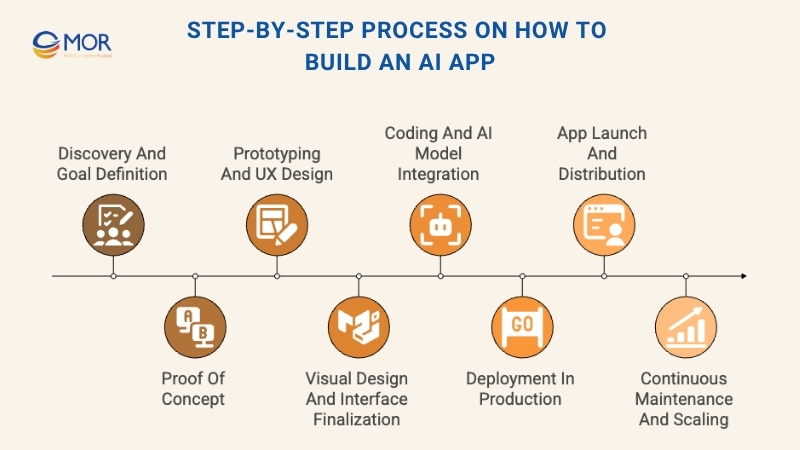
Below is a practical eight-step roadmap that covers everything from discovery to post-launch improvement:
Step | Description |
| 1. Discovery and Goal Definition | Identify your main objectives, audience, features, and technical stack to ensure alignment with user needs and market expectations. |
| 2. Proof of Concept (PoC) | Test AI models using sample data to confirm accuracy and performance before full-scale development begins. |
| 3. Prototyping and UX Design | Build an interactive prototype with core screens to validate the user journey and gather feedback. |
| 4. Visual Design and Interface Finalization | Refine the user interface, finalize layouts, and prepare design assets for smooth implementation. |
| 5. Coding and AI Model Integration | Develop the app’s front and back end while connecting the trained AI model and setting up automated workflows. |
| 6. Deployment in Production | Move the solution into a live environment and run stability tests to ensure reliable performance. |
| 7. App Launch and Distribution | Release the product to users through app stores or beta testing platforms, addressing review requirements and setup issues. |
| 8. Continuous Maintenance and Scaling | Track performance, roll out updates, and enhance features based on analytics and user feedback to keep the app growing. |
Step 1: Discovery and Goal Definition
Every AI project begins with discovery, no matter what kind of product you’re developing. This stage defines what the app should achieve, who it will serve, and how it aligns with your company’s goals. Understanding users and their needs is the key to shaping a successful concept.
The main results of this stage usually include:
- Clear business objectives
- One or two main features for the MVP
- A product roadmap with priorities
- An estimated tech stack and required tools
If you’re new to AI agent frameworks or unsure where to start, focusing on the problem you want to solve is enough. For instance, a healthcare startup might aim to reduce patient triage time through a chatbot so medical staff can handle more critical cases.
That’s a great starting point. Later, an experienced development team or AI consultant can translate that idea into technical terms, choosing the right architecture, data structure, and programming approach. This first step lays the foundation for everything that follows in how to build an AI app effectively.
Step 2: Proof of Concept (PoC): Testing the AI Model
Unlike standard app projects, AI application development includes an essential extra phase: building a proof of concept. Before moving to design or coding, the AI model must be tested to prove it works as intended.
At this stage, the product has little to no user interface. The focus is on feeding real or sample data into the model and studying how it responds. This helps determine whether the algorithms can learn correctly and deliver accurate outcomes. For example, a healthcare chatbot designed to triage patients must quickly and accurately identify the right care path in various test scenarios.
If the AI model cannot perform well during validation, continuing to development would be costly and unproductive. Testing early ensures that the system’s logic is sound before additional time and resources go into interface design or full integration. For anyone learning how to build an AI app, this step is where ideas are proven, or refined, to ensure lasting success.
Step 3: Prototyping and UX Design
After confirming the AI model works correctly, the next step is to design how users will interact with the app. Instead of building the entire interface, the focus here is on a few key screens that represent the core functions. These screens form a clickable prototype, allowing early testing and feedback before full development begins.
While the design team refines the interface, the machine learning engineer continue improving algorithms, setting up data pipelines, and optimizing model performance in the background. Both efforts progress together to keep the project efficient.
Testing a limited number of interactive screens helps measure user engagement and gather valuable insights. Feedback from this stage guides adjustments that make the interface simple, intuitive, and visually appealing. For anyone learning how to build an AI app, this approach saves both time and budget, ensuring the final product feels smooth and user-friendly before it reaches development.
Step 4: Visual Design and Interface Finalization
Once the prototype has been tested and refined, it’s time to complete the full design. This stage focuses on turning the approved layouts into a complete, consistent user interface. While designers polish the visuals, the development team often works in parallel to prepare the technical setup, keeping progress steady on both fronts.
With user feedback already incorporated, the goal now is to design every remaining screen, from the main dashboard to smaller sections like the user profile, Terms of Use, and Privacy Policy. Every interaction state, such as button presses, animations, or error messages, is defined clearly.
All UI assets are then organized into a structured design system. This makes it easier for developers to access and apply them consistently throughout the app. For anyone mastering how to build an AI app, this phase ensures the product looks cohesive, performs smoothly, and is ready for development without confusion or rework.
Step 5: Coding and AI Model Integration
Now comes the stage where everything starts taking shape. With the AI model trained and the design finalized, developers begin coding the application and connecting all parts into a functional system. The front end is built to match the approved design, while the AI logic works behind it to make the app intelligent and responsive.
At this point, the development team already knows the tech stack defined during discovery. They continue refining AI algorithms, ensuring smooth performance, and maintaining full alignment with design standards for iOS and Android.
Here are the main elements that define this phase:
- Agile Development: The team works in short sprints, releasing regular builds, sharing updates, and adjusting quickly to new feedback. This approach keeps everyone transparent and responsive to changing needs.
- Using or Training AI Models: Some projects use pre-trained AI models, while others build and train new ones from scratch. Both options can progress alongside coding, depending on complexity and desired accuracy.
- Cloud, On-Device, or Hybrid Deployment: Early planning helps decide where the AI engine will run. Cloud deployment supports multiple platforms, on-device processing suits offline or high-security tasks, and hybrid setups blend both for balance.
- DevOps and Automation: Continuous integration pipelines help generate new app builds quickly for testing and updates. This setup lets developers focus on improving features instead of manual packaging.
- Smart Use of Prebuilt Components: To save time and budget, ready-made modules like chat, scheduling, or authentication can be integrated easily. This lets the team focus resources on unique, high-value features.
Throughout this phase, ongoing QA ensures every new build performs correctly. Automated and manual tests verify functionality, security, and speed. Because most AI frameworks are cross-platform, a single codebase can usually support Android and iOS, making how to build an AI app both efficient and scalable from the start.
Step 6: Deployment in Production
Deployment marks the point when your app is ready to enter the real world. At this stage, the team sets up a production environment, a stable, secure server infrastructure designed to handle real user activity without interruptions.
Before release, both automated and manual tests are run on this live setup to identify any final bugs or performance issues. What used to be a difficult task years ago, especially when integrating with older systems, is now much smoother thanks to reliable DevOps pipelines.
A well-prepared deployment ensures that users experience a stable, responsive, and fully functional product from day one. For teams learning how to build an AI app, this is the step that officially turns months of work into a live, working solution.
Step 7: App Launch and Distribution
Once the final version is approved, it’s time to publish the app. Uploading it to platforms like the App Store or Google Play is simple when handled by a team familiar with submission rules and review processes. Experienced developers know how to avoid unexpected rejections and ensure a smooth release.
For limited launches, the app can be shared through TestFlight or beta testing programs. This approach allows early adopters to try the product, provide feedback, and confirm that everything runs properly before a full rollout. A well-planned launch gives businesses exploring how to build an AI app a chance to fine-tune user experience while preparing for marketing and scaling.
Step 8: Continuous Maintenance and Scaling
After release, maintenance begins immediately. The team monitors speed, stability, and user activity to identify bugs or usability issues. Analytics tools track how people actually use the app, revealing new opportunities for design or feature improvements.
An AI-driven application needs regular updates to stay accurate and relevant. With Agile workflows and DevOps pipelines already in place, the feedback loop between users, designers, and developers stays active. This ongoing process keeps the app improving and helps ensure it continues to deliver value over time.
That’s the full picture of how to build an AI app, a continuous cycle of learning, refining, and growing smarter with every iteration.
How Much Does It Cost To Build An AI App?
The cost of developing an AI app varies based on complexity, chosen technologies, and customization level. A basic AI app using APIs such as ChatGPT, PyTorch vs TensorFlow, or Google Cloud AI usually ranges from $20,000 to $50,000. A mid-range project with partial model training or system integration may cost $50,000 to $150,000, while a fully customized solution with advanced learning models, real-time analytics, and extensive infrastructure can exceed $200,000.
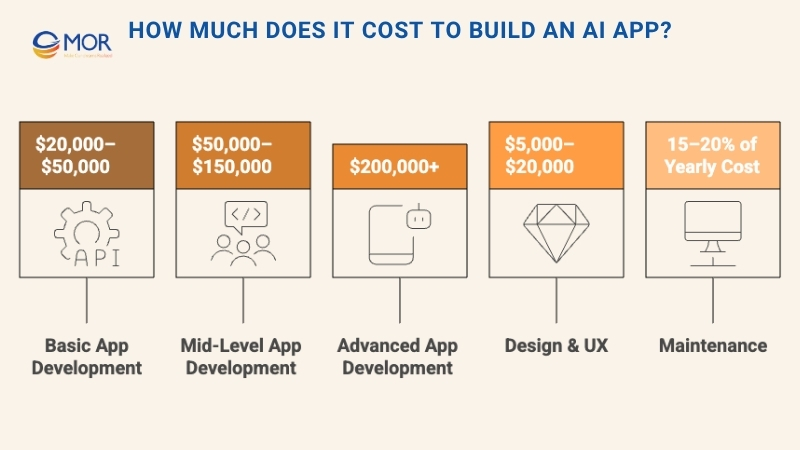
Several key factors shape the total budget:
- AI Functionality: Features like voice recognition, natural language processing, or predictive HR analytics require extra time and technical effort.
- Data Collection and Training: The size, quality, and labeling of datasets directly affect development costs.
- Development Method: Using pre-trained APIs is quicker and more affordable than building unique models from scratch.
- Design and UX: A polished, intuitive interface increases design hours and overall cost.
- Infrastructure and Maintenance: Cloud storage, server scaling, and ongoing updates add to long-term expenses.
How Long Does It Take To Build An AI App?
The time needed for how to build an AI app can range from several weeks to more than a year, depending on its complexity, scale, and objectives. A simple project that uses existing APIs like OpenAI or Google Cloud Vision might be ready within 4 to 8 weeks. However, a more advanced platform requiring custom model training, complex integrations, or large data processing could take 6 to 12 months or longer.
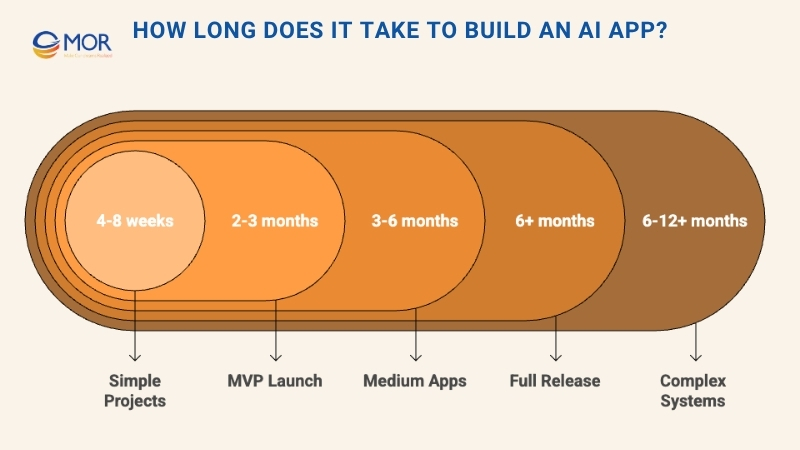
AI app development usually follows several key phases:
- Planning and Research (2–4 weeks): Define business goals, audience needs, and technical scope to set a clear direction.
- Data Preparation and Model Setup (4–12 weeks): Gather, clean, and label data before training or adjusting the AI model.
- Design and Development (8–16 weeks): Build the app interface, integrate backend logic, and connect the intelligent system.
- Testing and Deployment (4–8 weeks): Test real performance, fine-tune algorithms, and release the app into production.
Timeline variations often depend on team expertise, data quality, and technical infrastructure. A small, experienced team using pre-trained AI services can work faster, while research-heavy or regulated projects require more time.
Many teams start with a minimum viable product (MVP) to reduce risks. Launching an early version helps gather real user feedback and refine features step by step, ensuring every stage of AI application development leads to meaningful improvement.
Future Trends Influencing AI App Development
The world of AI application development continues to advance as computing power grows and access to data becomes easier. New tools and frameworks are pushing the limits of what smart systems can do, making them more adaptive, efficient, and useful in everyday life. Businesses should keep an eye on the following trends shaping the industry’s future.
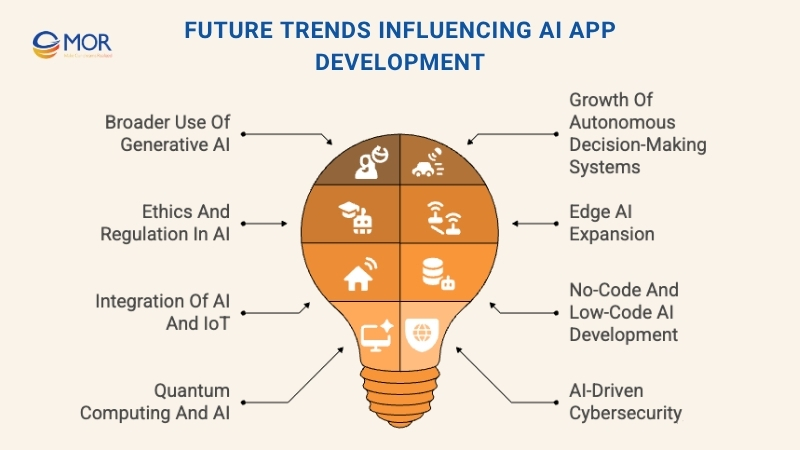
Broader Use of Generative AI
Generative AI is expanding fast, transforming how we create text, images, videos, and even music. Future improvements will allow these models to produce more detailed and realistic outputs, opening new opportunities in content creation, personalization, and automation. These innovations will let companies deliver richer user experiences and build smarter applications that respond naturally to each individual.
Growth of Autonomous Decision-Making Systems
AI systems are becoming capable of making real-time decisions with minimal human input. This technology is already redefining industries like transportation through self-driving vehicles, healthcare through AI diagnostics, and finance through predictive analysis. The next step is ensuring these systems remain safe, ethical, and transparent as they take on greater responsibility in critical environments.
Ethics and Regulation in AI
As artificial intelligence becomes a larger part of daily life, ethical responsibility and legal oversight will gain even more importance. Questions around data privacy, bias in algorithms, and automation’s effect on jobs will require clear, fair standards. Governments and organizations are expected to introduce stronger policies to make sure transfer learning development remains transparent, safe, and beneficial for society. These regulations will shape how businesses approach how to build an AI app responsibly in the coming years.
Edge AI Expansion
With the rise of smart homes, wearables, and industrial IoT, edge AI is becoming a key technology. Instead of sending data to the cloud, it processes information directly on devices, leading to faster responses, reduced bandwidth, and stronger privacy. As hardware improves and algorithms become more efficient, local AI processing will grow even more powerful, helping developers build apps that respond instantly without depending heavily on remote servers.
Integration of AI and IoT
The blend of artificial intelligence and the Internet of Things, known as AIoT, combines smart decision-making with connected devices. This connection lets machines analyze real-time data and act independently, from adjusting energy use in buildings to improving factory automation. The partnership between AI and IoT is driving a new generation of intelligent systems that learn continuously and interact more naturally with their surroundings.
No-Code and Low-Code AI Development
AI is becoming easier to access thanks to the rise of no-code and low-code tools. These platforms let people with little or no programming experience create intelligent applications through visual interfaces and prebuilt modules. This shift is helping more companies learn how to build an AI app without needing large technical teams. It also speeds up adoption across industries by allowing businesses to experiment, prototype, and deploy faster.
Quantum Computing and AI
Quantum computing is expected to redefine how AI systems process complex data. Although still early in its development, this technology could drastically accelerate model training, optimization, and data analysis. When applied to areas such as drug research or material design, quantum machine learning 2026 may uncover solutions that traditional computers cannot achieve today.
AI-Driven Cybersecurity
As digital threats become more advanced, AI will be vital for strengthening cybersecurity. Intelligent algorithms can spot suspicious behavior, detect anomalies, and respond faster than manual monitoring tools. Future systems will emphasize prediction, identifying potential attacks before they happen. Businesses that integrate AI into their security models will gain stronger protection, especially as online risks continue to grow.
These innovations highlight how fast AI application development is evolving. Staying aware of these trends helps organizations capture new opportunities, create smarter systems, and build technology that continues to enhance modern life.
Addressing Privacy, Security, And Compliance In AI App Development
Managing privacy, security, and compliance is a key part of how to build an AI app responsibly. As AI systems become central to modern businesses and everyday products, protecting user data and following global regulations is both a technical requirement and an ethical duty. Building trust through strong safeguards ensures that AI technology remains safe, transparent, and compliant across all environments.
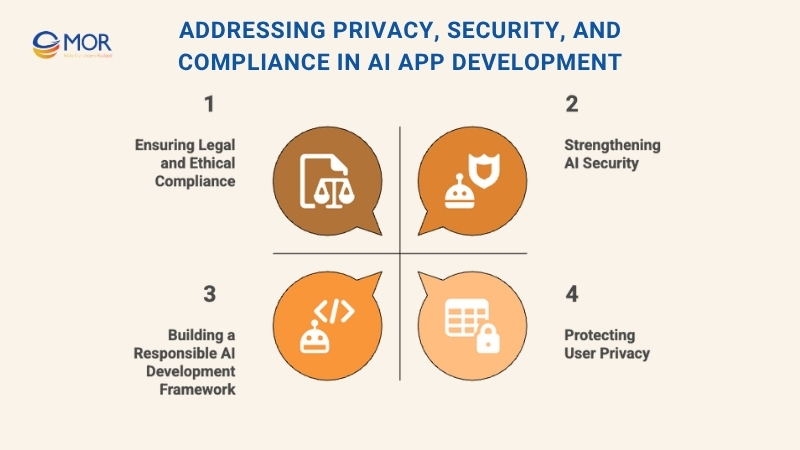
Protecting User Privacy
Privacy challenges often arise from the large amounts of data AI models require. Much of this information includes sensitive personal details, so protecting it is essential for maintaining user confidence and meeting standards such as the GDPR in Europe, the CCPA in California, and other regional privacy laws. Businesses exploring how to build an AI app must treat privacy as a core part of their design process, not an afterthought.
Best Practices for Safeguarding Privacy:
- Data Anonymization: Modify or mask personal data so that individual identities cannot be traced, reducing the risks of exposure during processing.
- Differential Privacy: Add controlled noise or variation to data queries, allowing useful analysis while preserving individual privacy.
- Secure Multi-Party Computation: Enable multiple parties to process shared data collaboratively without revealing private information to one another.
These strategies help organizations balance innovation with responsibility, ensuring that intelligent systems handle personal data securely and ethically.
Strengthening AI Security
Enterprise AI platform face many of the same cyber risks as traditional systems, but the consequences can be more severe because these applications make automated decisions. A successful attack could expose sensitive data, corrupt learning models, or manipulate outcomes through model poisoning and adversarial inputs. Protecting these systems is essential to maintaining trust and reliability in any intelligent solution.
Key Strategies for Building Secure AI Systems:
- Robust Authentication and Access Controls: Limit system access to verified users only, ensuring that sensitive AI models and data remain protected from unauthorized entry.
- Regular Security Audits: Perform detailed assessments to detect weaknesses early and fix them before they become exploitable threats.
- Adversarial Training: Expose models to potential attack patterns during development to strengthen their defenses against malicious or misleading data.
Implementing these security measures ensures that AI application development remains safe and resilient, protecting both user information and the integrity of the model itself.
Ensuring Legal And Ethical Compliance
Compliance plays a central role in responsible AI application development. Developers must align their products with data protection laws, ethical AI guidelines, and industry-specific regulations. Since policies evolve quickly, staying informed and adapting practices regularly is necessary to maintain trust and legal integrity.
Practical Steps for Staying Compliant:
- Regular Compliance Reviews: Monitor new regulations and AI governance updates while performing frequent system checks to confirm ongoing compliance.
- Ethical AI Frameworks: Establish internal policies that promote fairness, accountability, and lawful data use, reflecting both public expectations and legal requirements.
- Transparency and Explainability: Design AI systems that clearly show how decisions are made. This not only helps users understand outcomes but also supports growing global demands for traceable and interpretable AI models.
These actions help organizations build credibility, reduce risk, and ensure that every stage of how to build an AI app follows both ethical and regulatory standards.
Building A Responsible AI Development Framework
Managing privacy, security, and compliance effectively means treating them as core parts of AI application development, not as afterthoughts. These principles should be built into every stage, from planning and data design to model training and deployment. This approach minimizes risks, prevents breaches, and ensures that the final system remains trustworthy, transparent, and legally sound.
Working closely with legal advisors, cybersecurity experts, and ethics specialists throughout the process adds extra assurance. Their guidance helps confirm that each element of the AI lifecycle meets current regulations and is ready to adapt to future updates or new challenges.
In short, while these areas can be complex, they also create space for responsible innovation. Businesses that prioritize them not only protect users but also strengthen their credibility and competitiveness in a fast-moving AI market. This mindset is key for anyone learning how to build an AI app that is secure, ethical, and built to last.
Partner With MOR Software To Build Your Next AI App
At MOR Software JSC, we turn complex AI ideas into practical, high-performing applications. With over 850 completed projects across 10+ countries, our team has deep experience in developing mobile, agile web development, and cloud-based AI solutions tailored to each client’s goals.
We combine strategy, design, and engineering to create apps that learn, adapt, and deliver measurable value. From data architecture and model training to UX and long-term maintenance, every step is guided by precision and collaboration.
Whether you need a proof of concept or a fully deployed product, we help you build scalable, secure, and future-ready AI apps that fit your business vision.
Contact us today to explore how our AI development expertise can accelerate your next project.
Conclusion
Building an AI app takes planning, precision, and the right technical partner. Understanding how to build an AI app gives your business the power to automate smarter, deliver personalized experiences, and stay competitive in a fast-changing market. With MOR Software, you gain a trusted team experienced in AI development, cloud integration, and long-term product growth. Ready to turn your AI vision into reality? Contact us today to start building your intelligent solution.
MOR SOFTWARE
Frequently Asked Questions (FAQs)
Can I build an AI app on my own?
Yes, you can build an AI app yourself using no-code or low-code platforms, or by following open-source tutorials. Tools like TensorFlow, PyTorch, and OpenAI APIs make it easier to train and deploy simple models without deep technical expertise.
Is it hard to develop an AI app?
It depends on your goals and technical background. Basic AI apps can be built using existing APIs and pre-trained models, while complex ones involving machine learning, natural language processing, or custom algorithms require more time, data, and programming skills.
Can I create an AI app for free?
You can start for free using open-source libraries and free-tier services like Google Cloud AI, Hugging Face, or OpenAI’s trial APIs. However, advanced features such as high-volume data storage, training, and hosting may require paid upgrades later.
What do I need before I start building an AI application?
You’ll need a clear problem to solve, access to relevant data, and a basic understanding of how machine learning works. Choosing the right tech stack, defining user needs, and planning for scalability are also key to a successful AI app.
How much does it cost to make an AI app?
Costs vary widely depending on complexity. A simple AI app using pre-trained APIs might cost around $20,000–$50,000. More advanced apps with custom AI models and large datasets can range from $150,000 to $200,000 or more.
How long does it take to build an AI app?
Timelines depend on the project scope. Simple prototypes can take 1–2 months, while enterprise-level AI solutions with model training, complex features, and testing may take 6–12 months or longer.
What programming languages are best for AI app development?
Python is the most popular choice due to its extensive AI and machine learning libraries. Other languages like Java, C++, and JavaScript are also widely used, especially for production-level deployment and frontend integration.
How do AI apps make money?
AI apps can generate revenue through subscription models, in-app purchases, data analytics services, or SaaS offerings. Some also monetize through API access, advertising, or by licensing their AI models to other companies.
What are the biggest challenges in building an AI app?
The toughest parts are collecting high-quality data, managing training costs, and ensuring your model performs accurately in real-world scenarios. Developers must also address ethical issues like data privacy and algorithmic bias.
How can I use AI to build an app?
You can use AI frameworks and APIs to automate core app features like chat, recommendations, or image recognition. Start by identifying a task AI can enhance, then use tools like TensorFlow, OpenAI, or IBM Watson to integrate smart functions without coding from scratch.
Rate this article
0
over 5.0 based on 0 reviews
Your rating on this news:
Name
*Email
*Write your comment
*Send your comment
1